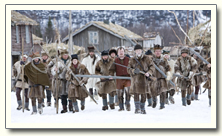|
Reel Norden: Nordic Film & History:
The film, The Kautokeino Rebellion,
accurately depicts the uprising and gives the audience
insight into this event from a Sami perspective. The
film goes through many of the events that led up to the
Rebellion. The main events that bring about the
rebellion are the teachings of Laestadius and Kautokeino
receiving a new minister.
This image depicts Elen meeting Laestadius for the first
time. This is an important moment in the film because
once Elen and the town turn towards Laestadianism, it
provides an answer to the destructive alcoholic
lifestyle.

The film begins by illustrating the
prevalence of the drinking problem in the Sami village
of Kautokeino. The central character of the film is Elen.
Her husband Mathis is seen intoxicated at the general
store of a non-Sámi merchant named Ruth, and Elen must
take him away before he is beaten. The decision by
director Nils Gaup to open the film in this way is
crucial to prefacing the coming uprising. Following the
incidents at Ruth's, Elen and her family traveled to the
village of Karesuando to purchase supplies, where they
also listened to Swedish revivalist pastor Lars Levi
Laestadius preach.

Laestadius' teachings inspired a
religious movement, known as Laestadianism, which
focused on the forgiveness of sin and the betterment of
the sinners. Followers of the Laestadian movement were
expected to abstain from drinking alcohol. In the
northern Lapland region, Laestadianism became a reaction
to the growing alcohol abuse problem in the 1840s.
Laestadianism preserved the Sami culture and identity
through using the Sami language in religious services
and legitimizing that living in poverty was not
something to be ashamed of. Laestadians took pride in
not owning more than what was necessary. The Sami
culture clung to this movement because alcoholism had
been quite destructive to their lifestyle, and
Laestadianism provided an alternative.
Upon returning to Kautokeino, Elen
began to hold meetings with the local people to spread
the words of Laestadius and stop the heavy liquor
consumption. The events leading up to the actual
rebellion transpired similarly. The Sami held meetings
in an attempt to awaken the people, which were largely
successful as they led to a strong opposition by Ruth
and his men. The film accurately depicts the exposure
and subsequent spread of a new religious mindset in the
village.
As depicted in The Kautokeino Rebellion, Niels V.
Stockfleth is the minister that comes to Kautokeino by
the request of Ruth. Before Stockfleth showed up there
had been a minister who would come and go with only
short, sporadic visits to preach to the people. During
the time after Elen and her family came back to
Kautokeino from Karesuando, she started to preach about
what Laestadius was preaching. Since the new religion
looked down on drinking liquor, Ruth's store continued
to lose business. More and more Sami were converting to
the Laestadianism that Elen was preaching.
The final scenes of the film
illustrate the climax of the rebellion with the violent
actions of the rebellious Sami group. On November 8,
1852, a group of Sami people rebelled and killed the
local tradesman Carl Johan Ruth and the sheriff Lars
Johan Bucht, and burned down the tradesman's house.

In real life, there were five people
that were convicted, including Elen, and other Sámi
community members named Aslak and Mons. Elen
Aslaksdatter Skum was the first sentenced to death, but
was granted remission to lifelong penal servitude. On
October 14, 1854, Aslak Jakobsen Hætta and Mons Aslaksen
Somby were executed by decapitation. The killings of
Aslak and Mons were depicted correctly in the film, as
the closing scene shows the two men being beheaded in a
public setting.
Some historians have theorized that a
few of the rebels of the Kautokeino Rebellion were
mentally ill, and that was the reasoning for the
violence. Other historians claim that the violence was a
result of a misled religious interpretation of the
teachings of Laestadius. Their interpretation of
Laestadianism led the rebels to believe that they needed
to "exorcise" the evil of alcoholism completely from
their community by killing the merchant, Ruth, and his
associates.
The movie incorporated the basic historical facts of the
rebellion accurately. The names of the main characters
involved are correct and the timeline of events during
and after the uprising itself is accurate. The
Kautokeino Rebellion did what it could to portray
the event within the constraints of the media in which
it was created. The film provided an insider's view of
the uprising from a heretofore ignored Sami perspective
and gave its audience insight into an event that
occurred more that 150 years ago.

|